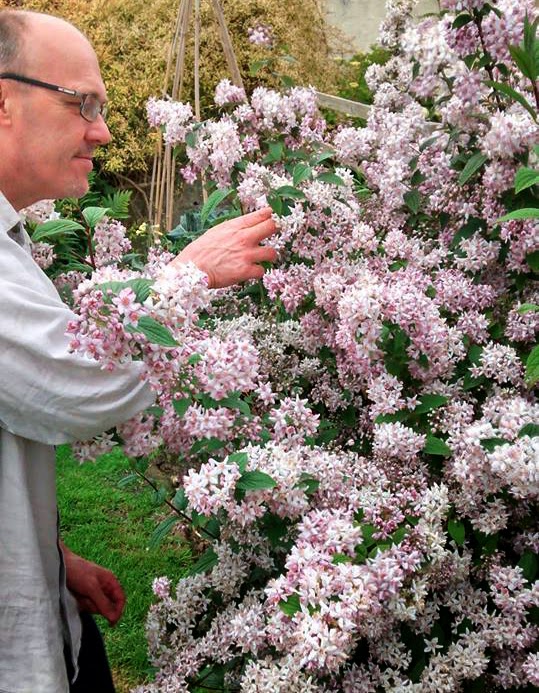Having
a good sniff of the early flowering Deutzia X hybrida 'Mont Rose’
We have a lovely flowering Deutzia X hybrida 'Mont Rose’
shrub in the garden. It has a slightly aromatic scent and attracts load of
bees. It’s a stunning, colourful start to our shrub collection year and it’s
the first time I’ve seen it in flower.
The reason for this is that I have been a bit enthusiastic
with my pruning since moving into the house three years ago. I didn’t let the
shrub grow as that it has a tendency to hang over the fence and go into the neighbour’s
garden. I am also limited for space on the bed it grows in and leaving it
untended means less room for vegetable’s to be planted. This year I decided
just to let it grow and I am really pleased I did. The blooms are amazing.
So how can I make sure that the shrub flowers as well next
year and why should we prune shrubs?
Why prune shrubs?
Shrubs create the structure in a garden so it's important to
keep them in good condition with regular pruning. Regular pruning, usually after flowering along
with mulching and feeding will help the shrubs to look good. Regular pruning
will also help to keep the shrub in its allocated space and not take over the
garden.
How and where to cut
Use sharp tools and make clean cuts without leaving snags.
Cut close to buds, but not into them, and always above which will stop rotting.
Pruning young shrubs
- Early pruning helps establish a shapely shrub with vigorous, balanced growth.
- Most evergreen shrubs do not need thinning or formative pruning. However all shrubs benefit from shortening any excessively long shoots and cutting out weak or damaged growth.
- Deciduous shrubs are more likely to need pruning into shape; this is known as ‘formative pruning’. Young shrubs often grow lots of shoots so you will have to thin them early on.
- ‘Correct lopsided growth by lightly pruning longer shoots and hard pruning weak stems.
Rejuvenating old
shrubs
Shrubs such as forsythia and buddlea can soon accumulate
masses of old, dead wood in the centre if they are not pruned regularly. The
best way to rejuvenate these plants is to cut them back during the dormant
season. First cut out dead, diseased and crossing stems, and then thin the
number of remaining stems by half.
Shrubs that respond to severe pruning, such as ribes,
philadelphus and my Deutzia specimen may be cut almost to ground level to
re-establish a framework of new shoots. If the shrub is old and it's hard to
predict a successful revival, take cuttings just in case.
Pruning shrubs in
pots
A lot of us have shrubs in pots. Once a container shrub
reaches maturity it is usually best repotted annually in spring, or every other
year, using the same or similar sized container. If you find the plant is very
pot-bound, this is a good time to lightly prune the roots. Prune about
one-third of the thicker non-fibrous roots back to the intact rootball, but
avoid damaging the fibrous feeder roots. Repot in fresh compost and finish by
pruning the top growth by about one-third to balance the root loss.
Coppicing and
pollarding shrubs
Shrubs grown for their colourful stems or foliage, such as
dogwood, need to be cut down every spring to 4-5 buds to encourage new growth. This
is known as coppicing. If you want to keep a framework of older stems, cut down
one-third of the stems.
A similar technique is called ‘pollarding’ where stems are
cut back to the same point a single stem or framework of stems. After pruning,
feed and mulch the plant.
Pruning shrubs in
autumn
After a summer's vigorous growth, it is a good idea to give
your shrubs a light prune in the autumn to keep them in shape. Once deciduous
shrubs lose their leaves, it is easy to see the plants' overall shape and
decide what needs to be cut back.
Pruning my Deutzia
In a week or so the flowers will have gone. It will be then
that I can cut the shrub back and cut out the old flowering stems. I have some
mulch to go around the base to help feed and keep in the moisture.
As the shrub will be contained and reduced dramatically in
size, I will be able to plant annual vegetable crops around and underneath it,
so it’s a win –win situation. I didn’t get one complaint from the neighbour
either.
